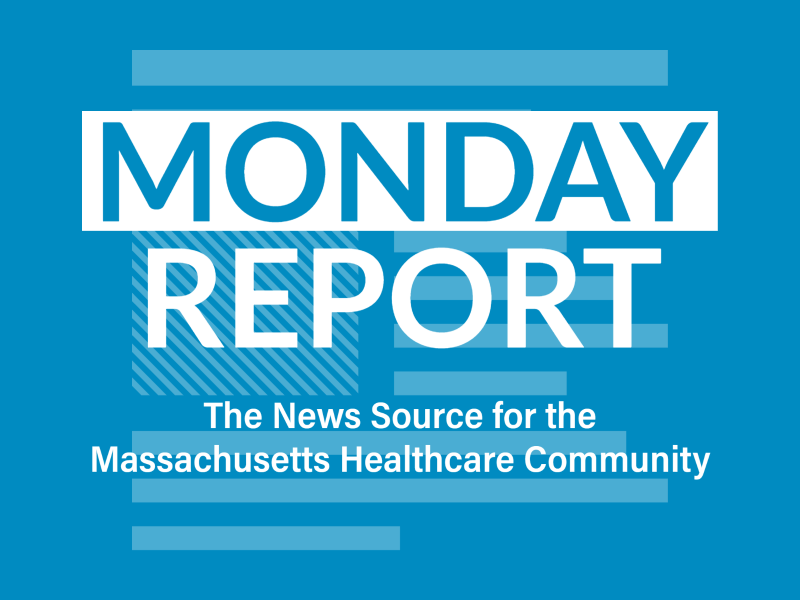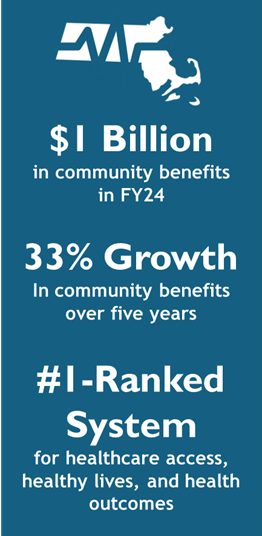$1B in Community Benefits; Immigration Guidance

INSIDE THE ISSUE
> $1 Billion for Community Health
> Revised CBO Figures
> 2026 Aligned Measures
> Immigration Guidance
MONDAY REPORT
Hospitals’ $1B Answer to Rising Demand for Community-Based Care
As a time when two-fifths of the commonwealth’s residents reported difficulty accessing care, Massachusetts hospitals devoted more than $1 billion to community-based programs in FY24, according to the Attorney General’s new report. Hospitals’ community benefits investments have increased by 33% over the past five years; 2024 marks the second straight year their contributions have topped $1 billion.
Hospital-funded “community benefit” programs have become an increasingly vital part of the state’s healthcare infrastructure. Hospitals undertake an extensive outreach process with their communities and local partners – such as schools, faith-based groups, and nonprofits – to identify the specific health needs in their area. They also follow the Attorney General’s guidelines, which include priorities for communities in every region.
From there, hospitals invest in programs that make a difference – well beyond the walls of their facilities. In partnership with local organizations, they have created mobile health vans for neighborhood health screenings, launched nutrition and chronic disease management programs close to patients’ homes, and rolled out initiatives focused on addiction treatment and violence prevention – among dozens of other programs aimed at addressing the real-time needs of their service areas. All of these programs come at no cost to the residents being served, health insurers, or the government.
“As our communities face continuing disparities in healthcare access, the Community Benefits program fills a gap in community health by encouraging our hospitals and HMOs to use their resources to creatively tackle pressing public health issues across the commonwealth,” said Attorney General Andrea Joy Campbell. “I am encouraged to see Massachusetts hospitals and HMOs developing programs to help our residents access services that improve their social determinants of health.”

These community investments are taking place as hospitals confront extraordinary pressures, including escalating costs, tight capacity constraints, and persistent workforce shortages. Adding to the strain, the Health Safety Net, which funds care for low-income, uninsured, and underinsured patients at hospitals and community health centers, is projected to face a $290 million shortfall by the close of the hospital fiscal year on September 30, 2025, the largest deficit in the program’s history. This funding gap, shouldered solely by hospitals, is compounding the financial stress already threatening hospitals’ long-term sustainability.
“Our hospitals don’t just heal patients and fuel Massachusetts’ economy, they open doors for healthier lives in every neighborhood across the commonwealth,” said Steve Walsh, MHA’s president and CEO. “The AG’s report is a powerful reminder that, even though providers and patients are enduring profound challenges, hospitals have only expanded their mission to invest in communities and take on those challenges. Each community benefits dollar has touched a life, made care more accessible, and helped us manage downstream healthcare costs in the state.”
Among the contributions spotlighted by the Attorney General’s Office for FY24:
Brigham and Women’s Faulker Hospital’s partnership with the Manning School in Jamaica Plain established programs to enrich students’ wellness curriculum, encourage early awareness of how to foster good health, and help students deal with outside factors that may interfere with their health. In FY24, more than 125 students in grades 1-4 received four health classes per month, over 100 students participated in health career lessons, and students in grades K-3 received garden lessons to learn about growing food, life cycles, and healthy foods.
Heywood Healthcare, in partnership with the CHNA9 Health Equity Partnership established a Maternal Care Hub of North Central MA, made up of members representing various sectors, including healthcare, behavioral health, domestic violence, nutrition, doulas, political leaders, and community members from diverse backgrounds to inform and support maternal health strategies and enhance access to high-quality, culturally competent maternal care.

Lahey Hospital & Medical Center partnered with the Burlington Police Department to provide funding to support a mental health clinician as a substance use coordinator to provide outreach to persons identified by police as having substance use issues. In FY24, the clinician assisted 191 individuals and families.
MHA has catalogued additional “Commitment to Community” hospital contributions here. These efforts have helped Massachusetts earn the #1 Health System Ranking from the Commonwealth Fund in 2025 – including in areas such as access and affordability, healthy behaviors, and health outcomes.
Hospitals will file their FY2025 community benefits reports in spring of 2026. Read more about hospital community benefits at mhalink.org and on the Attorney General’s webpage, and click on the short video above to see a brief explanation of the community benefits process.
CBO’s Latest Report: Dips in Coverage and Household Income for Most
The bipartisan Congressional Budget Office, in response to an inquiry from Democratic legislators, last week released a new study on the effects of the recently passed One Big Beautiful Bill (OB3).
The bill was notable for its $1 trillion cut to Medicaid and the Supplemental Nutrition Assistance Program (SNAP), as well as for its tax cuts.
The CBO, building on its similar report issued in June, found that as a result of OB3, “U.S. households, on average, will see an increase in the resources available to them over the 2026– 2034 period. The changes in resources will not be evenly distributed among households. The agency estimates that, in general, resources will decrease for households toward the bottom of the income distribution, whereas resources will increase for households in the middle and toward the top of the income distribution.” Specifically, households in the lowest tenth of income distribution will see their annual household income decline by 3.1%. Those in the fifth and sixth deciles (the middle range) will see their income rise by 1%. Those in the highest decile will see a 2.7% increase in income.
As for Medicaid enrollment, the CBO’s latest report shows that the office is maintaining its original estimate that 10 million current enrollees will lose coverage over the next decade. Some 2.4 million fewer Americans, including families with children will lose SNAP benefits under the bill, the CBO found.
State Releases 2026 Aligned Measure Set
When providers enter into global contracts with payers, the terms of the contract require caregivers to meet certain quality measures as a condition of getting paid. Examples include ensuring that providers have plans in place for controlling high blood pressure or to assess for clinical depression or substance use. In the past, each health plan could use a different slate of measures, requiring providers to keep track ff the varying requirements.
But in 2017, the state created the Quality Measure Alignment Taskforce made up of representatives from provider organizations, commercial and Medicaid managed care health plans, academic experts, consumer advocates, and state agencies. Its goal was to standardize the voluntary measures across all payers.
Each year the taskforce reviews the Core Set of measures that payers and providers are expected to use in their global budget-based risk contracts, and the Menu Set that payers and providers may choose from to supplement the core set. There can also be a Monitoring Set that includes measures that the taskforce identified as representing a priority area of interest; an On Deck Set of measures that may eventually be moved into the Core or Menu sets; a Developmental Set that includes measures with defined specifications that have been validated, tested, and/or are in use in other states that the taskforce has elected to track; and the Innovation category that includes measures tracked by using a novel approach or clinical topics that are not addressed in the other sets.
Last week, Executive Office of Health & Human Services Secretary Kiame Mahaniah, M.D., signed off on the 2026 measure set that will affect contracts beginning January 1, 2026, and beyond. This document gives an overview of the 2026 changes, and this is the complete measure set.
State Employer Guidance on Immigration Issues
Governor Maura Healey and Attorney General Andrea Joy Campbell last week jointly released a guidance document to assist employers confronted with the rapidly changing work status of immigrants due to the Trump administration’s actions.
Under new federal rules revoking the Temporary Protected Status or “parole” status of workers from various countries, the healthcare workforce in Massachusetts stands to lose thousands of employees. Many personal care workers in nursing homes will be especially affected, affecting a sector of the care continuum already facing large workforce vacancies.
Clarity on the situation is made all the more difficult because many of the administration’s actions have been challenged in court and currently remain unresolved.
The state guidance alerts employers that “it is unlawful for an employer to knowingly hire or continue to employ a person who is unauthorized to work in the United States,” but also that “employers should be careful not to assume that someone is unauthorized to work solely because they are dealing with immigration issues or have a temporary status, particularly when those matters are unresolved or subject to ongoing legal review.”
The guidance also notes that “Termination of an employee because they may lose employment authorization in the future can be considered discrimination and generally should not occur. For employees on a temporary status, employers should explore and accept alternative work authorization grounds from alternative work statutes or provisions of law. To ensure compliance with these overlapping obligations, employers should consult with an attorney to obtain advice regarding work authorization verification practices.”

 Massachusetts Health & Hospital Association
Massachusetts Health & Hospital Association